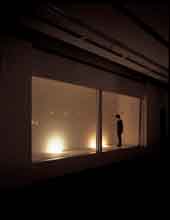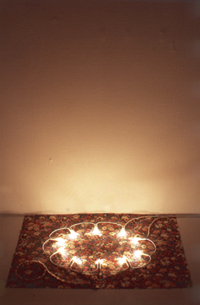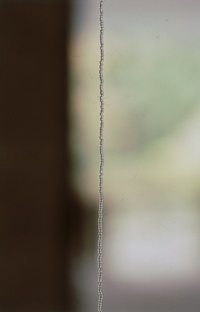 |
|
Here and There introduces art, artists, galleries and museums around Japan that non-Japanese readers and first-time visitors may find of particular interest. The writer claims no art expertise, just a subjective viewpoint acquired over many years' residence in Japan.
|
|
 |
|
|
 |
 |
Ghosts in the Showcase: Rei Naito at the Museum of Modern Art, Kamakura
Alan Gleason |
 |
 |
|
 |
| Rei Naito's "What Kind of Place Was the Earth?" (2009) fills an entire gallery with a soft, otherworldly light. (Miniature lights, printed cloth, tape, ribbon, buttons, balloons, beads, thread, line, glasses, water, glass balls, mirrors, bells) |
|
A visitor contemplates "What Kind of Place Was the Earth?" from inside one of the large showcases. |
My first encounter with the art of Rei Naito came too late to introduce it in this column before her most recent exhibition, Tout animal est dans le monde comme de l'eau à l'intérieur de l'eau, closed at the Museum of Modern Art, Kamakura on January 24, 2010. But she exhibits frequently, has permanent installations in various parts of Japan, and as I discovered, her work is well worth seeking out.
 |
Close-up of one of the floral
lights-and-fabric motifs in "What
Kind of Place Was the Earth?" |
The centerpiece of Naito's Kamakura show was the new installation "What Kind of Place Was the Earth?" Entering the gallery, I found myself in a room dimly lit by intermittent patches of light emanating from the showcases lining the walls. Close-up, I saw that the glow came from nests of tiny Christmas tree lights, arranged like petals upon squares of floral print fabric. Above, small balloons and smaller glass balls dangled like ripe fruit from the ceiling of the showcase, swaying gently in the air currents generated by the heat of the lamps. Little jars of water stood here and there at random intervals.
At first glance, I was less than overwhelmed. The floral patterns of the lights and cloth struck me as too cute, almost kitsch. I wondered if that was the impression Naito intended. But as my eye was drawn to the movement of the balloons, the entire composition gradually came together, as if by its own natural inclination.
After a while I realized I had been standing there in a state of unthinking rapture, unaware of the passage of time. Terms like "Zen" and "meditative" get bandied about with annoying redundancy when we try to describe the more quietistic aspects of Japanese art, but these words apply to Naito's work if they do to anyone's.
A soft voice shook me out of my reverie; it turned out to be a museum staffperson, whispering an invitation to remove my shoes and step up into one of the showcases. Naito had made it possible for visitors to enter her installation, to stop and savor, from within, the mystical mood evoked by the interplay of air and light. Viewed from outside the showcase, the parade of silent strollers inside was like an apparition of another world -- the afterlife, perhaps.
Born in 1961 in Hiroshima, Naito gave her earliest shows alarming titles like Apocalypse Palace, but over time her work has evolved in a profoundly spiritual direction, concerned with expressing the interconnection of all things. A stellar example of this is her permanent installation on the island of Naoshima in the Inland Sea, created in 2001. As part of the Art House Project to revive abandoned houses on the island, Naito reinvented the interior of the Kinza residence with an idiosyncratic placement of poles, ropes, and various small objects to produce an atmosphere redolent of both cutting-edge abstraction and warm rural tradition.
In her notes about the Kinza installation, which she titled Being Given, Naito writes: "There was already a space. I thought, 'Why do I have to manipulate it?... Why change it?'" Her Kamakura installation may represent a culmination of this philosophy, for she has created an emotionally powerful environment with simple materials and only the slightest alteration of the exhibition space.
The Kamakura museum lends itself well to Naito's work. Designed by Junzo Sakakura, a student of Le Corbusier, and built in 1951, it was Japan's first museum devoted to modern art. A handsome, not-too-starkly-modern structure that utilizes rusting steel girders to attractive effect, it juts out over the Heike Pond on the precincts of Tsurugaoka Hachiman Shrine, one of the ancient capital's major tourist attractions. That the museum blends in so well with its surroundings can be credited to the fact that Sakakura took inspiration from the Katsura Detached Palace, one of the most celebrated examples of traditional Japanese architecture in that other ancient capital, Kyoto.
 |
Part of Rei Naito's "Grace" (2009). A single strand of beads hangs from the sculpture gallery ceiling. (Beads and line, 1.5 mm in diameter; ceiling height 3000 mm)
|
On the ground floor terrace overlooking the pond, Naito has installed another series of works, collectively titled "Grace," that interact with and complement the design of the museum with strands of beads strung in various configurations -- a vertical line from a gallery ceiling, a bow-like curve over the railing facing the pond. In the central courtyard, two wisps of string suspended from an invisible wire cavort wildly in the breeze. With such minimal elements, Naito draws us gently but irresistibly into the embrace of everything around us.
 |
Another component of "Grace" (2009) suspended from the terrace roof overlooking the Heike Pond. (Beads and line, 2 mm in diameter, 5.5 m in width and 2.6 m in height)
|
|
 |
Exterior view of the Museum of Modern Art, Kamakura, extending over the Heike Pond at Tsurugaoka Hachiman Shrine.
All photos except exterior museum view by Naoya Hatakeyama;
courtesy of The Museum of Modern Art, Kamakura
|
|
|
 |
|
 |
Naito Rei |
 |
The Museum of Modern Art, Kamakura |
 |
14 November 2009 - 24 January 2010 |
 |
|
 |
2-1-53 Yukinoshita, Kamakura, Kanagawa Prefecture
Phone: 0467-22-5000
Hours: 9:30 - 17:00 (last admission at 16:30)
Closed Monday (except for national holiday), day after national holiday, and New Year holidays (29 December - 3 January)
Transportation: 10-minute walk from Kamakura Station (JR Yokosuka Line or Enoden Line), on the grounds of Tsurugaoka Hachiman Shrine |
 |
|
|
 |
 |
Alan Gleason
Alan Gleason is a translator, editor and writer based in Tokyo, where he has lived for 25 years. In addition to writing about the Japanese art scene he has edited and translated works on Japanese theater (from kabuki to the avant-garde) and music (both traditional and contemporary). |
|
|
|
 |
 |
|